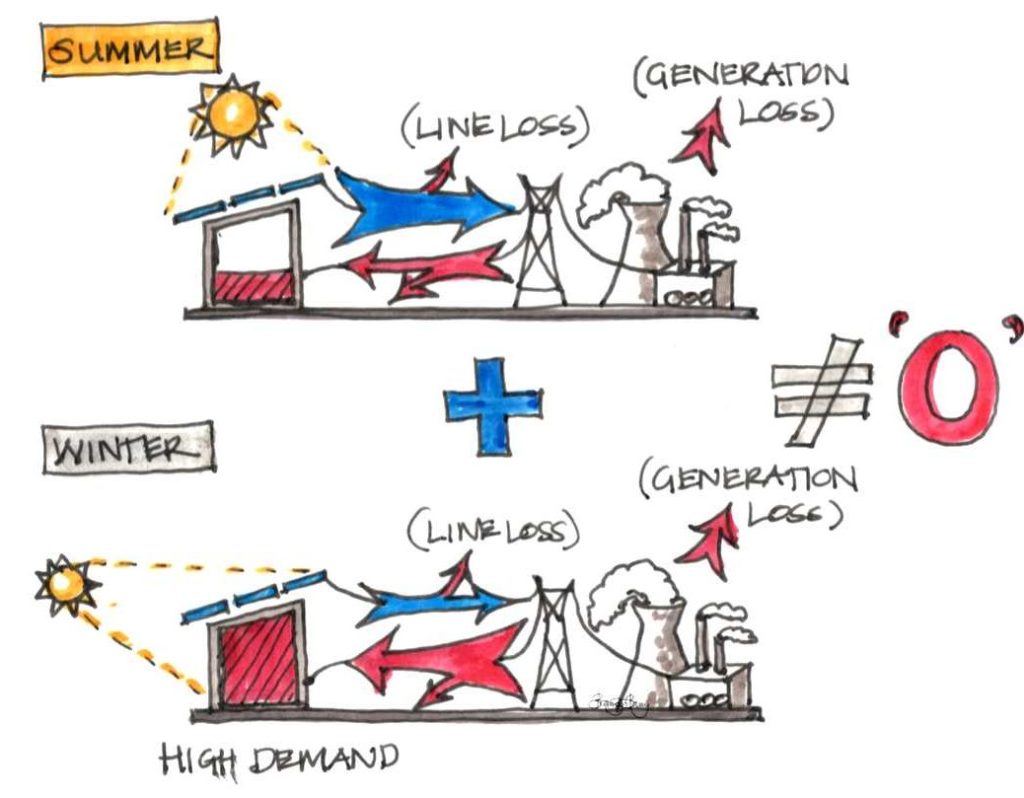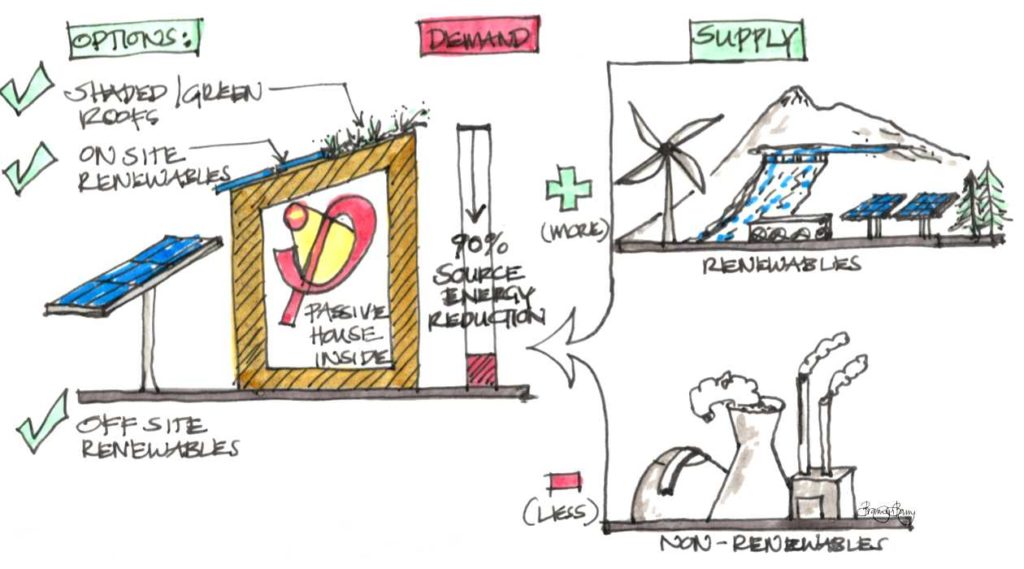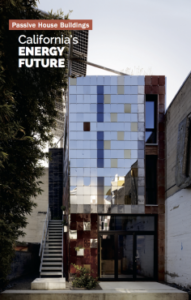Author: Bronwyn Barry (Passive House California)
If you’ve been puzzled by the proliferation of ‘net’, ‘nearly’ and ‘almost ready’ Zero Energy definitions and standards and have wondered just how ‘net’ or ‘nearly’ they truly are, take heart. The Passive House Institute has introduced an equitable assessment of energy use to help guide us toward the 100% renewable energy future our State—and planet—must rapidly achieve.

Figure 1. Why site ‘Zero’ is not source ‘Net Zero’: Transmission and generation losses are accounted for in Source ‘Zero’ (Original illustration by author)
Inspired in part by the impressive leaps in the efficiencies of renewable energy generation, coupled with the urgency of meeting global climate change goals, the Passive House Institute initiated a review of non-renewable energy use in buildings in 2013. They recognized that their previous calculations for Primary Energy needed updating, especially as they favored the use of natural gas over electricity (Primary Energy accounts for all the source energy used by a building, including the amount of energy it takes to generate and transmit power to the building site). The Passive House Institute recognized that non-renewable forms of energy use by buildings needed to be rapidly phased out, so they devised a method to incentivize the use of renewable forms of energy in buildings. Their research resulted in the overhaul of the existing Passive House ‘Classic’ standard and the introduction of two new standards: Passive House Plus and Passive House Premium.

Figure 2. Passive House Inside: Integrating of renewable energy options in Classic, Plus and Premium Passive House buildings (Logo use with permission, Passive House Institute. Original Illustration by author.)
Primary Energy Renewable ‘Factors’ and how they work
All of the new Passive House standards now calculate Primary Energy using Primary Energy Renewable (PER) factors. These are designed to encourage the use of renewable energy sources and create either incentives, or disincentives, for installing various types of mechanical equipment in Passive House buildings. For example, in San Francisco, using a heat pump water heater to produce hot water will result in lower Primary Energy requirement numbers than using a gas tank water heater would, making it easier to meet the certification target. (A heat pump water heater has a PER factor of 1.25 versus the 1.75 factor for a gas-fired water heater.)
PER factor calculations are based not only on fuel source, but also on site-specific load profiles calculated on an hourly basis. In this way, variations in regional utility grid source energy and typical time-of-day use profiles, which impact the availability of renewable energy to meet a utility’s load, for the local climate and region are factored into these calculations. As a result, the PER factors can vary from city to city in California. For example, the electricity PER factor for heating demand via heat pumps is 1.80 in Sacramento. This relatively high PER factor incentivizes reducing heating demand in winter, when renewable energy supplies are low. In San Diego the comparable PER factor is set at 1.30, where the climate is milder and cooling is typically a greater peak load issue.
Crediting renewable energy equitably
Conventionally, calculations of net zero depend on the difference between a building’s annual energy demand and annual on-site renewable energy production. These calculations penalize tall buildings with small roof areas, buildings with no solar access, or buildings that opt to use their roof area for green space or as active living spaces. The Passive House Insitute took a major deviation from such traditional methods for crediting renewable energy supply to buildings, recognizing that all sites are not created equal in this regard. The Passive House Institute’s approach uses the following principles:
-Renewable offsets are calculated as a function of Projected Building Footprint (PBF) rather than total floor area. PBF is more proportional to available roof area than total floor area, which means multi-story buildings may achieve the Plus and Premium standards.
-Buildings with no solar access on site may purchase off-site renewable energy facilities to achieve Plus or Premium certification.
-PH ‘Classic’ Buildings with no on-site or off-site renewable energy supply are still optimized for efficiency first and a future grid supply of all renewable energy.

Figure 3. An equitable calculation for renewable energy generation (Original illustration by author)
Biofuels, Microgrids, and Battery Storage
While biofuels are considered a renewable energy source, they carry a penalty for replacing food production. Their burning also generates particulate matter that is both unhealthy and emits carbon. For these reasons, the use of biofuels is allowed, but has been capped to limit its use.
The most intriguing areas of innovation with regards to manifesting the 100% renewable energy future currently look to be in developing our capacity to store renewable energy. We’re excited by the contributions being made right here in California to develop technologies that are contributing to our new energy future. Existing storage capacity from hydroelectric schemes is now being joined by a growing array of affordable short- and long-term battery storage options. Converting renewable energy into methane gas is another rapidly developing technology that could increase the viability of renewable energy by allowing us to store it for longer.
Remarkably, these options are all currently supported by the Primary Energy Renewable calculations embedded in the Plus, Premium, and Passive House Classic standards. Indeed, the ‘Classic’ standard at the heart of all of them remains the foundation that most equitably supports an all-renewable energy future. The Classic standard ensures that these buildings are optimized to become batteries themselves: they’ve been proven to retain an unprecedented level of thermal comfort while eliminating peak loads. This optimization ensures that even without the addition of ‘active’ power, their passive capacity is what is literally doing the heavy lifting. These buildings enable occupants to survive in adequate comfort for very lengthy periods of time without any active energy inputs. This quality offers economic benefits to both the utilities and microgrid designs  of renewable energy storage systems that extend well beyond comfort. Just imagine what we could do with renewable energy if we didn’t need so much of it to simply operate buildings? The possibilities are boundless.
of renewable energy storage systems that extend well beyond comfort. Just imagine what we could do with renewable energy if we didn’t need so much of it to simply operate buildings? The possibilities are boundless.
This article was first published by Low Carbon Productions in the print copy of ‘Passive House Buildings: California’s Energy Future,’ produced in collaboration with Passive House California. We’d like to give special thanks to Mary James, publisher at Low Carbon Productions and the editor and lead author of the book. Additional articles and California project examples may be viewed in the free online e-book or you can download a pdf copy of the book.
References:
© International Passive House Association, 2018. Unauthorized use and/or duplication of this material without express and written permission from this site’s author and/or owner is strictly prohibited. Excerpts and links may be used, provided that full and clear credit is given to International Passive House Association with appropriate and specific direction to the original content.






 Carl supports our international communication activities and is the point of contact for administrative enquiries.
Carl supports our international communication activities and is the point of contact for administrative enquiries.